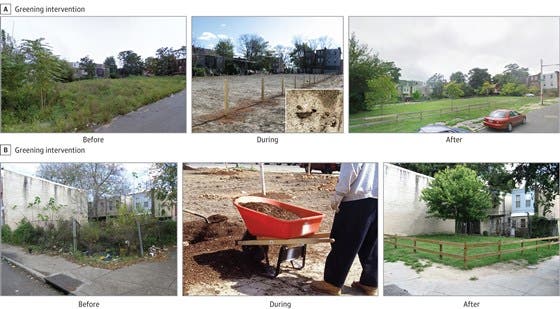There’s a been a lot of debate around the value of green areas in cities, and growing evidence suggests that these areas can do a lot to improve our mood and even our mental health. A new study found that transforming vacant lots into green areas can lower feelings associated with depression, especially in poorer neighborhoods.

No one really likes dirty, abandoned lots — but is this a minor inconvenience, or does it have a lasting effect? In what is one of the very few studies on the effects of public spaces on mental health, researchers from the University of Pennsylvania assessed the effect that greening vacant lots had on the neighborhoods’ inhabitants.
They tracked the emotional state of 342 local residents from 2011 to 2014, during which the Philadelphia Horticultural Society cleaned up and planted trees in several vacant lots. Researchers found that residents of areas that had either greening or trash removal projects nearby reported a decrease in feelings of depression by around 40%. The effect was even more pronounced in neighborhoods below the poverty line — the drop was 70%. Comparable results were reported for feelings of worthlessness, hopelessness and overall poor mental health, all of which are feelings associated with depression.
For residents near lots that were not cleaned out, all those feelings remained largely unchanged, so it seems that the greening of the lots made all the difference.
[panel style=”panel-default” title=”Greening vacant lots” footer=””] The greening intervention involved removing trash, grading the land, planting new grass and a small number of trees, installing a low wooden perimeter fence, and performing regular monthly maintenance. The trash cleanup intervention involved removal of trash, limited grass mowing where possible, and regular monthly maintenance. The control group received no intervention.[/panel]
Of course, researchers note that although greening seems to do a lot to improve the mental health of people, it is not a substitute for a proper medical treatment — merely a way to complement them.
“The remediation of vacant and dilapidated physical environments, particularly in resource-limited urban settings, can be an important tool for communities to address mental health problems, alongside other patient-level treatments,” researchers write in the study.
Dr. Eugenia South, an emergency room doctor at the University of Pennsylvania Hospital and a corresponding author of the study, says that this is further evidence that where people live has an impact on their health. A similar study in Flint, Michigan found that maintaining the gardens of vacant lots can help reduce crime — and similar results were reported in a different study of the same plots in Philadelphia.
Previous research has shown that dilapidated spaces, trash, and a lack of quality of infrastructure are associated with depression, South and colleagues write:
“Vacant and dilapidated spaces are unavoidable neighborhood conditions that residents in low-resource communities encounter every day, making the very existence of these spaces a constant source of stress and possibly mental illness.”
The cleaning and greening also had another positive effect, bringing the community closer together — which in turn, does a lot to improve the mental health of people.
South hopes that urban planners and policymakers can learn from this, especially considering that almost 1 in 5 US adults report some form of mental illness, and this is a very cost-effective way to alleviate some of this problem. Speaking to a local newspaper, South emphasized how cost-effective these measures could be:
“This really is a relatively low-cost intervention compared to the amount of money that is spent on other health problems,” she explained.
It’s also interesting to note (although this wasn’t followed in the study) what the environmental effect of this clean-up is. Although they may reduce depression and improve mental wellbeing, parcels with grass and trees don’t really have that much environmental value. Mowed lawns are ecological deserts, whereas even uncared-for parcels with longer grass and weeds can be more useful for urban wildlife (especially pollinators). It would be interesting to see how this type of maintenance also consider this aspect, and also implement native plants and flowers — perhaps it would do even more to raise spirits, while also helping the city’s little critters.
Journal Reference: South et al. “Effect of Greening Vacant Land on Mental Health Community-Dwelling Adults.”


